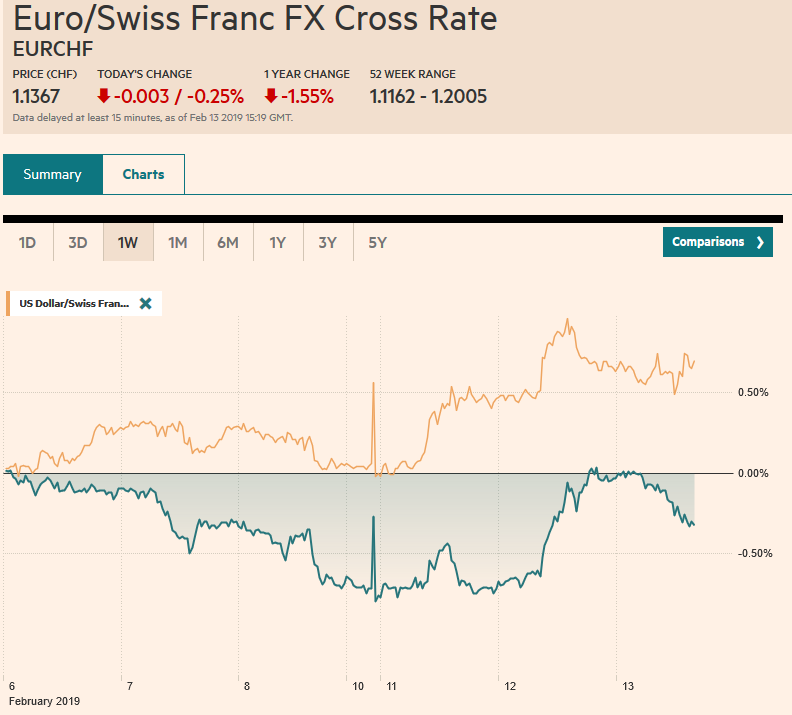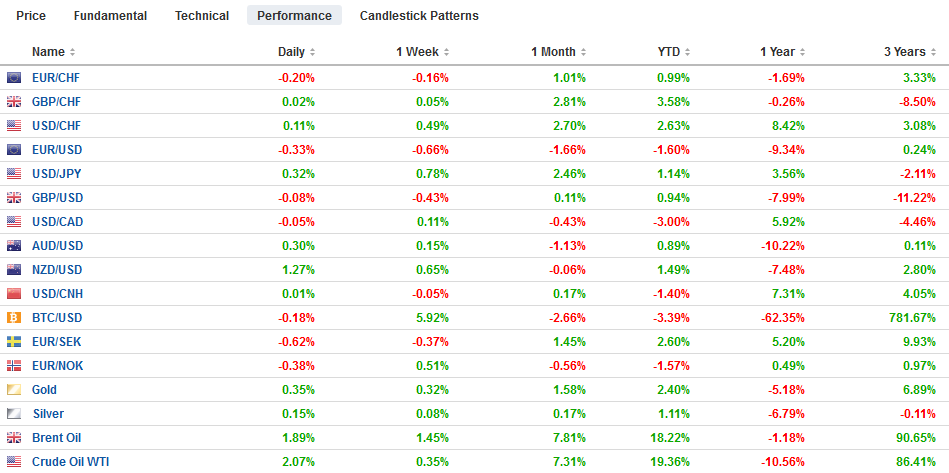Swiss Franc The Euro has fallen by 0.25% at 1.1367 EUR/CHF and USD/CHF, February 13(see more posts on EUR/CHF and USD/CHF, ) Source: markets.ft.com - Click to enlarge FX Rates The Federal Reserve has long been clear on the sequence of events as it innovated the playbook during the Great Financial Crisis. There would be a considerable period between when the Fed would finish its credit easing operations that involved purchasing Treasuries and mortgage-backed securities (MBS) and its first-rate hike. The normalization cycle would be well underway before the central bank would allow its balance sheet to shrink. The early days of the recovery were weak, and a few rounds of asset purchases were deemed necessary
Topics:
Marc Chandler considers the following as important: 4) FX Trends, Featured, Federal Reserve, Interest rates, newsletter, QE, QT
This could be interesting, too:
Nachrichten Ticker - www.finanzen.ch writes Die Performance der Kryptowährungen in KW 9: Das hat sich bei Bitcoin, Ether & Co. getan
Nachrichten Ticker - www.finanzen.ch writes Wer verbirgt sich hinter der Ethereum-Technologie?
Martin Hartmann writes Eine Analyse nach den Lehren von Milton Friedman
Marc Chandler writes March 2025 Monthly
Swiss FrancThe Euro has fallen by 0.25% at 1.1367 |
EUR/CHF and USD/CHF, February 13(see more posts on EUR/CHF and USD/CHF, ) Source: markets.ft.com - Click to enlarge |
FX RatesThe Federal Reserve has long been clear on the sequence of events as it innovated the playbook during the Great Financial Crisis. There would be a considerable period between when the Fed would finish its credit easing operations that involved purchasing Treasuries and mortgage-backed securities (MBS) and its first-rate hike. The normalization cycle would be well underway before the central bank would allow its balance sheet to shrink. The early days of the recovery were weak, and a few rounds of asset purchases were deemed necessary before officials were convinced that deflationary forces were arrested and the economy had entered a self-sustaining recovery and expansion. In 2017, nine years after Lehman failed, the Fed announced plans to gradually reduce its balance sheet by not reinvesting the entire amount of maturing proceeds. The pace would quicken quarterly until reaching $50 bln a month in Q4 18. |
FX Performance, February 13 |
I recall reading only one note that warned that through its balance sheet operations the Fed would tighten more than it realized and that was from Benn Steil and Benjamin Della Rocca over the Council on Foreign Relations (November 2017 here). While equities were cratering at the end of last year, many picked up Steil’s argument. I argued against Steil’s early warning at the time, and the subsequent iterations have not made it more compelling.
To be sure, the argument is seductive. When the Fed’s balance sheet was expanding, officials assured us, financial conditions were easing. The econometricians calculated that every $1 trillion of asset purchases was tantamount to 15-20 bp lower interest rates. As the process went into reverse, financial conditions should be expected to tighten, and rates rise.
Investors in risk-free assets were displaced by the Federal Reserve purchases and were forced to buy riskier assets. As the Fed’s balance sheet shrank, high-risk assets would lose this bid. The narrative is straight-forward and logical. There is one problem: the facts. With the Fed buying fewer Treasuries and the government issuing more, bond yields should have risen but instead, have fallen. The US 10-year yield peaked in November near 3.25% and today are below 2.70%. The impact on mortgage rates has also been counter-intuitive. Thirty-year mortgage rates are closer to 4.5% than the 5% rate seen in the middle of Q4 18.
What about equities? The S&P 500 reached a record high about a year after the Fed’s balance sheet began shrinking. The sell-off in Q4 18 was violent. Investors were looking for a culprit, and Steil’s balance sheet argument was ready-made and helped by a tweet from President Trump that also referred to the reduction of the balance sheet.
Equities have come roaring back, not just in the US but also the riskier emerging market equities. The Federal Reserve’s rhetoric has changed, and it may raise rates less this year less than the two times signaled in December. However, the balance sheet continues to shrink, though operationally the pace is closer to $40 bln a month than $50 bln.
If we are to conclude that Quantitative Tightening (QT) is not really tightening financial conditions, what are we to make of Quantitative Easing (QE)? The econometricians want to measure quantities of both flows and stocks, but price changes do not align.
The conventional narrative puts too much weight on quantities and not enough emphasis on signaling. If QE was really about quantities, it is difficult to explain the apparent diminishing impact after the first round, or the seemingly less impactful though greater quantities were involved in the eurozone. Indeed, in the six weeks or so that the ECB has stopped buying assets, bond yields have fallen. The Germany 10-year yield fell to a two-year low recently, a little below 10 bp. Its curve is negative out nine years. For its part, the Bank of Japan has gradually reduced the number of government bonds it buys without having a perceptible impact, and the 10-year yield is a little below zero.
Quantitative easing was the swapping of the Fed’s creation (reserves) for Treasuries and MBS. To the extent that financial conditions eased, it was because the Fed was signaling its intention. This may sound sacrilegious, but monetary policy is not solely but it largely a confidence game. Fed officials may or may be true believers of their narrative about how the stocks (holdings) are more important than the flows (purchases), but it did seem to strengthen what we suggest is mostly a placebo effect.
The Fed says now that monetary policy will be conducted primarily through the Fed funds target and the interest paid on reserves (all reserves not just excess reserves). The balance sheet reduction, it says, is a technical issue now, though it could be used again if necessary (if the zero bound is being approached). Daly, the new San Francisco Fed President, recently suggested that the Fed’s balance sheet could become a tool under “normal” times not just in extremis, but there seems to be little appetite for that among her colleagues.
If not QE, what drove rates down? Round up the usual suspects: weak growth and low inflation. As explanatory variables, growth and inflation (and expectations) appear to be more robust than central bank purchases. The eurozone grew 0.7% in each quarter in 2017 that is why rates rose despite the ECB’s purchases. US rates rose in 2018 as fiscal stimulus hit goosed an economy that was already growing above trend. Rates fell at the end of the year as growth began disappointing and the fiscal stimulus was fading.
From another perspective, the low price of money (interest rates) would seem to imply a surplus of supply relative to demand. The idea that there could be too much capital is absurd to many observers and economists. There can be too much of anything but capital. Yet it is common to speak of excessive debt. This is affirmation through negation, after all, one person’s liability is another’s asset.
There are around $8 trillion of bonds today that continue to offer a negative yield. The central bank of Japan and many countries in Europe (not just EMU, but also Switzerland, Sweden, and Demark) have negative deposit rates. If anything else had a negative return like this, economists would quickly identify incongruence between supply and demand.
Modern governments (representative or otherwise) are reluctant to allow the economy to fully clear (what Andrew Mellon cried during the Great Depression” Liquidate. Liquidate. Liquidate”). Capital is not sufficiently destroyed at the end of the business cycle, which has gotten longer and flatter. Modern military conflicts do not destroy enough capital. The commanding heights of the 21st-century economy are not nearly as capital intensive as the 20th-century economy. Consider the FAANGs compared with US Steel and the Generals (Motors and Electric) or Sears and Amazon.
We live in a Midas Moment. The gods of yore cursed King Midas by giving him what he wanted: The golden touch. Whatever he touched turned to gold. It was fine when it was a tree, but it was disastrous when he hugged his daughter or tried drinking wine. So, too in our day. We are cursed with abundance and the surfeit of capital, which is difficult to recognize given the common ideological lens and the gross disparity of its distribution.
The QE/QT hypothesis cannot explain interest rate movements during the operations or after the purchases have ceased. US rates often fell on the announcement of QE and rose during the actual operation. An alternative hypothesis that capital is like other factors of production and can be in surplus suggests interest rates may remain low for a protracted period. It recognizes that monetary policy is not simply a scientific expression of the transformation of quantities, but it is a signaling device of intentions and desires. Like the marginal reserve system itself, it is ultimately about confidence, and in this regard is more like transubstantiation than building an airplane.
Graphs and additional information on Swiss Franc by the snbchf team.
Tags: Featured,Federal Reserve,Interest rates,newsletter,QE,QT

